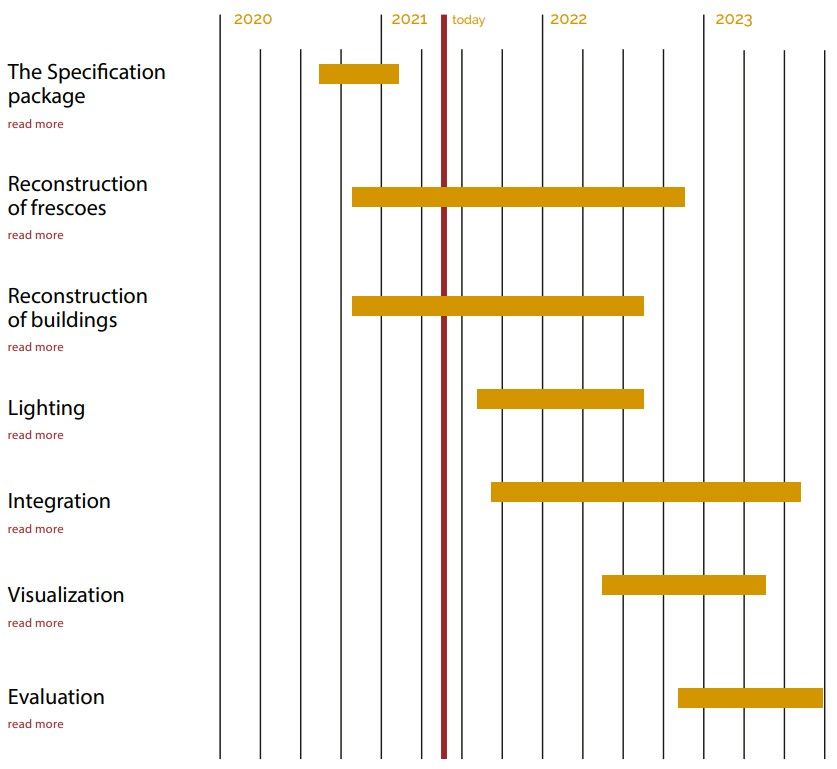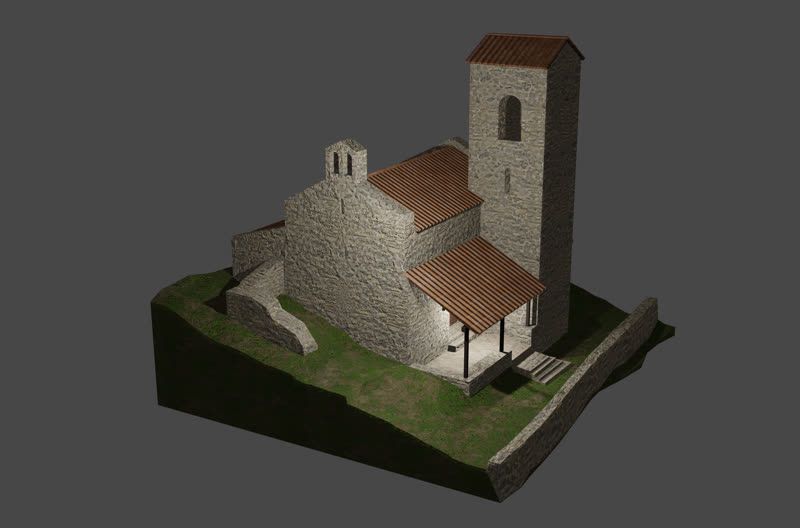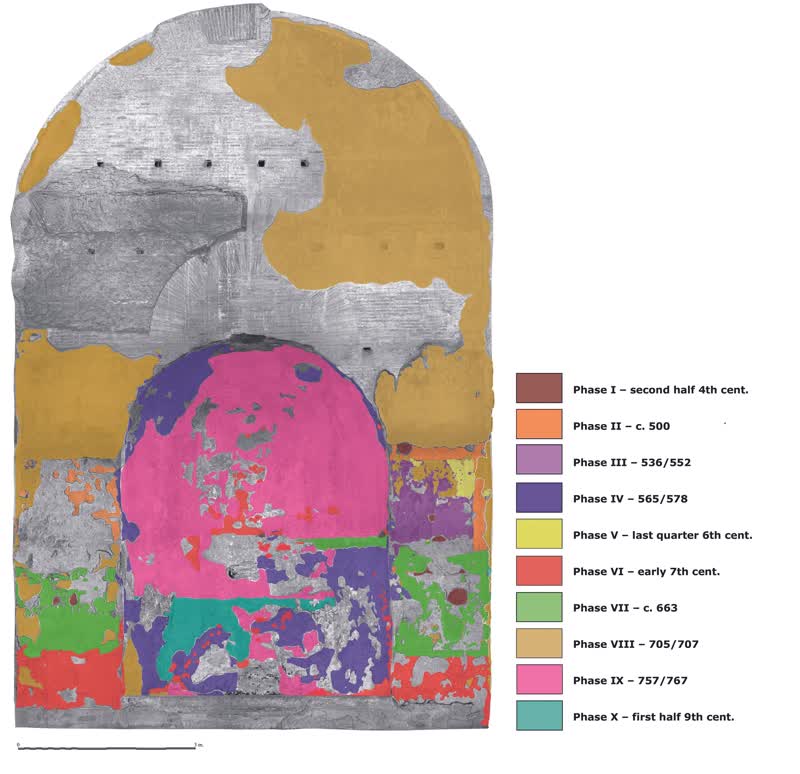methodology
EHEM aims to build digital models of historical monuments with a twofold objective: to monitor them and to leave a trace of their present state and future evolution.
We intend to achieve this by creating 3D architectural models, based on LIDAR scanning and photogrammetry; which incorporate the reconstruction of the painted wall surfaces and their natural and artificial illumination.
Part of the creation of these models relies on engineering research: while we don’t need a visualisation of a video game we do require a digital facsimile. These models are based on scrupulous historical, philological, theoretical, and field investigations: our proposed reconstructions can not be based on historiographical clichés or on superficial analysis of data. Through an interdisciplinary methodology we strive to create an instrument that allows us to protect and monitor monuments.
In order to preserve medieval pictorial and architectural heritage, we must move from recreational to conservative uses of technology.
virtual restoration of medieval wall paintings
Today, medieval monuments present themselves with the changes they have undergone over the centuries. During the Middle Ages the relationship between painting and architecture was mutually dependent. Our aim is to restore the medieval painted decoration to its original context, showing how this changed over time on the walls of the same building. At present, medieval wall-paintings often appear to us as a overlapping of successive decorative campaigns, heavily restored or detached and taken out of context, sometimes lost but documented by historical drawings or photos. The project’s objective is to recreate the link between the painting and the monument using 3D models: virtually relocate the detached paintings to their original location and showcase the different chronological decorative phases on a wall. We intend to do this by digitising the frescoes through photographic and photogrammetric surveys restoring their legibility by integrating them in a philologically correct manner and virtually retrieving their colour as close as possible to the original with the help of scientific multispectral surveys and colour analysis.
3d model reconstruction of medieval churches
Our aim is to showcase the actual modifications and adaptations of the buildings across the Middle Ages in high-fidelity 3D models. To accomplish this goal, the buildings are digitised using photogrammetry and laser scanning. The raw output is point clouds which are then used to generate textured 3D meshes. With the purpose of preserving high-resolution colour detail of the wall paintings, new algorithms for mesh reconstruction and simplification are explored. Simplified 3D polygonal meshes are thereby generated. These will be tailored to the needs of cultural heritage sites with medieval wall paintings, where the required colour sampling rate can be an order of magnitude higher than the geometry sampling rate. At the same time, the plans and layouts of the buildings will be recovered during their various phases, paying particular attention to measurements of the sites at different times in their medieval past.
restoring natural and artificial lighting in 3d models
After their removal from the walls, mural paintings, whether exhibited on site or in a museum, are illuminated for their current vision with artificial lights that standardize, and even expose parts that were not intended to be shown . In a virtual reconstruction, and in our project in particular, we try to restore the illumination and, therefore, the intended perception of the paintings . The reconstruction of the phases of the buildings allows us to know in detail how they were illuminated from the openings at different times of the day during the seasons. It is a cliché in medieval documentation that a light should permanently illuminate any church and, in particular, the space of the liturgy. They refer to candlesticks, oil lamps and other light fixtures whose original arrangement is not always easy to reconstruct. This artificial illumination, which was particularly important during the celebration of religious ceremonies and their reconstruction, should allow us to reproduce the reverberation it generated on the paintings. Ultimately, this will foster a closer understanding of the paintings by their intended recipients during the liturgical office. In order to satisfy these requirements we shall incorporate the knowledge on the original use of light in the single monuments. These includes the characterising features of the openings, which are different in each of the three case studies of the project, and precise models of the artificial light sources that also differ in accordance with the structure of each site. Special attention will be paid to show how the use of light highlighted relevant elements for the liturgical use of the scene.
integration (semantically enriched models)
Digital reconstructions are essential to represent the geometric and visual appearance information of Cultural Heritage. In the context of EHEM, these reconstructions will provide a suitable representation of architecture and paintings of the chosen sites which are deemed representatives of medieval artistic heritage. These digital reconstructions also provide a valuable support to link all the heterogeneous information about facts, hypotheses and studies, in the form of annotations or additional resources attached to the object (texts, images, videos, sounds…). Typically, data management tools for Cultural Heritage allow art historians to create the annotations directly on 2D images that have been calibrated with respect to the 3D digital model. With this objective we aim to enrich the 3D models with semantic information. In the spirit of FAIR data, we will adopt well-established tools such as aioli. Aioli is a cloud-based, collaborative platform for cultural heritage documentation, safeguarding, and sharing of data. Since the platform supports multi-temporal analysis, it is suitable for the diachronic perspective of EHEM.
visualisation
We will develop dedicated applications to enhance the experience of the painted buildings by presenting their 3D models during the Middle Ages while considering the lighting effects to different target groups. The applications will be implemented using game engines that support emerging technologies (such as Virtual Reality – VR), allowing users in turn to experience the sites in multiple ways such as headsets and mobile devices. The combination of these technologies allows gamification aspects. The requirements of the applications will be formulated by researchers in art history, restorers and curators. Accordingly, suitable research, scientific, and curatorial scenarios will be drafted. In relation to the general public, scenes will be selected by art historians and other stakeholders in order to raise the interest of a broader audience.
project evolution





